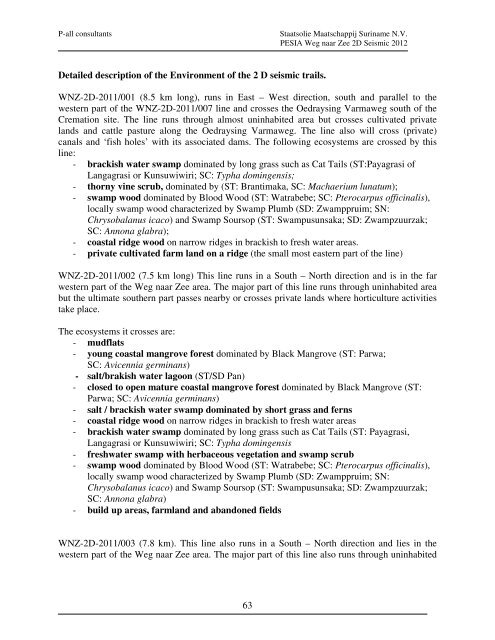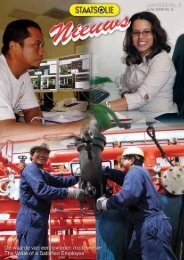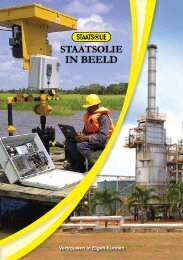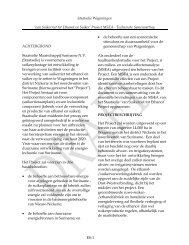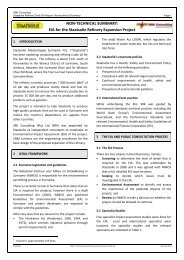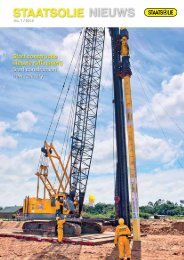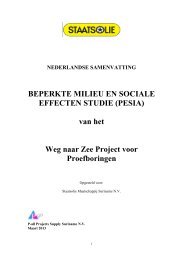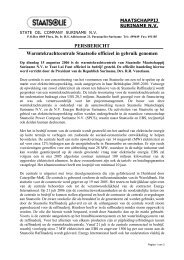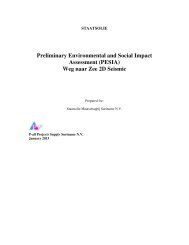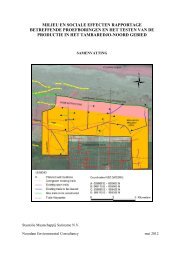(PESIA) Weg naar Zee 2D Seismic - Staatsolie
(PESIA) Weg naar Zee 2D Seismic - Staatsolie
(PESIA) Weg naar Zee 2D Seismic - Staatsolie
You also want an ePaper? Increase the reach of your titles
YUMPU automatically turns print PDFs into web optimized ePapers that Google loves.
P-all consultants <strong>Staatsolie</strong> Maatschappij Suriname N.V.<br />
<strong>PESIA</strong> <strong>Weg</strong> <strong>naar</strong> <strong>Zee</strong> <strong>2D</strong> <strong>Seismic</strong> 2012<br />
Detailed description of the Environment of the 2 D seismic trails.<br />
WNZ-<strong>2D</strong>-2011/001 (8.5 km long), runs in East – West direction, south and parallel to the<br />
western part of the WNZ-<strong>2D</strong>-2011/007 line and crosses the Oedraysing Varmaweg south of the<br />
Cremation site. The line runs through almost uninhabited area but crosses cultivated private<br />
lands and cattle pasture along the Oedraysing Varmaweg. The line also will cross (private)<br />
canals and ‘fish holes’ with its associated dams. The following ecosystems are crossed by this<br />
line:<br />
- brackish water swamp dominated by long grass such as Cat Tails (ST:Payagrasi of<br />
Langagrasi or Kunsuwiwiri; SC: Typha domingensis;<br />
- thorny vine scrub, dominated by (ST: Brantimaka, SC: Machaerium lunatum);<br />
- swamp wood dominated by Blood Wood (ST: Watrabebe; SC: Pterocarpus officinalis),<br />
locally swamp wood characterized by Swamp Plumb (SD: Zwamppruim; SN:<br />
Chrysobalanus icaco) and Swamp Soursop (ST: Swampusunsaka; SD: Zwampzuurzak;<br />
SC: Annona glabra);<br />
- coastal ridge wood on narrow ridges in brackish to fresh water areas.<br />
- private cultivated farm land on a ridge (the small most eastern part of the line)<br />
WNZ-<strong>2D</strong>-2011/002 (7.5 km long) This line runs in a South – North direction and is in the far<br />
western part of the <strong>Weg</strong> <strong>naar</strong> <strong>Zee</strong> area. The major part of this line runs through uninhabited area<br />
but the ultimate southern part passes nearby or crosses private lands where horticulture activities<br />
take place.<br />
The ecosystems it crosses are:<br />
- mudflats<br />
- young coastal mangrove forest dominated by Black Mangrove (ST: Parwa;<br />
SC: Avicennia germinans)<br />
- salt/brakish water lagoon (ST/SD Pan)<br />
- closed to open mature coastal mangrove forest dominated by Black Mangrove (ST:<br />
Parwa; SC: Avicennia germinans)<br />
- salt / brackish water swamp dominated by short grass and ferns<br />
- coastal ridge wood on narrow ridges in brackish to fresh water areas<br />
- brackish water swamp dominated by long grass such as Cat Tails (ST: Payagrasi,<br />
Langagrasi or Kunsuwiwiri; SC: Typha domingensis<br />
- freshwater swamp with herbaceous vegetation and swamp scrub<br />
- swamp wood dominated by Blood Wood (ST: Watrabebe; SC: Pterocarpus officinalis),<br />
locally swamp wood characterized by Swamp Plumb (SD: Zwamppruim; SN:<br />
Chrysobalanus icaco) and Swamp Soursop (ST: Swampusunsaka; SD: Zwampzuurzak;<br />
SC: Annona glabra)<br />
- build up areas, farmland and abandoned fields<br />
WNZ-<strong>2D</strong>-2011/003 (7.8 km). This line also runs in a South – North direction and lies in the<br />
western part of the <strong>Weg</strong> <strong>naar</strong> <strong>Zee</strong> area. The major part of this line also runs through uninhabited<br />
63


